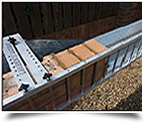How Lauren's Ladder Works
This product has evolved over 12 years. Starting off as a balsa wood prototype, Mick just had individual ladders made by Mick Reed of Amicon Engineering in Peterborough as he needed them. With the help of his brother, Lionel, Mick has patented it, found a manufacturer and a distributor and estimates that the payback time for the system will be in around four to five houses only (or less on band coursing). It brings peace of mind that the brickwork is correct, neat, complies with Building Regulations and is ready for follow-on trades.
(Diagram 1). Adjuster screws will allow the face of Laurenís Ladder to be tilted if necessary to accommodate existing out of plumb brickwork, and clamps allow for cavity width adjustment on brick, block traditional walls or timber frame.

(Diagram 2). Once set up, the gaps in Laurenís Ladder show exactly where each brick of the soldier course should be placed. No string line, no measuring and no boat-level work required. All the bricklayer has to do is lay each brick behind the ladder using the top bar as a level, and the vertical bars as a mortar joint.

(Diagram 3). The bricks are held securely in place and in Mickís opinion, a solider course using this method can be completed in half the time it would normally take, giving a massive saving on band course work where teams of bricklayers just simply connect their ladders to each others.
